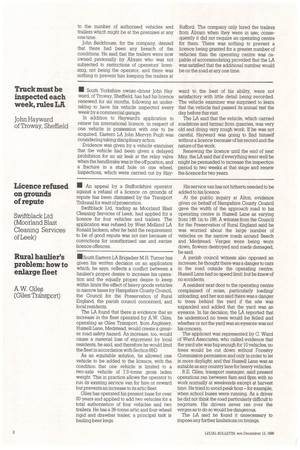Rural haulier's problem: how to enlarge fleet
Page 16

If you've noticed an error in this article please click here to report it so we can fix it.
InSouth Eastern LA Brigadier M. H. Turner has given his written decision on an application which, he says, reflects a conflict between a haulier's proper desire to increase his operation and the equally proper desire to keep within limits the effect of heavy goods vehicles in narrow lanes by Hampshire County Council, the Council for the Preservation of Rural England, the parish council concerned, and local residents.
The LA found that there is evidence that an increase in the fleet operated by A W. Giles, operating as Giles Transport, from Anglesey, Hussell Lane, Meolstead, would create a greater road safety hazard. An increase, too, would cause a material loss of enjoyment by local residents, he said, and therefore he would limit the fleet m accordance with Section 69D, As an equitable solution, he allowed one vehicle to be added to the licence, with the condition that one vehicle is limited to a two-axle vehicle of 7.5-tonne gross laden weight. This m practice allows the operator to run its existing service van for hire or reward but prevents an increase to its artic fleet.
Giles has operated his present base for over 50 years and applied to add two vehicles for a total authorisation of four vehicles and two trailers. He has a 38-tonne artic and four-wheel rigid and drawbar trailer; a principal task is hauling beer kegs. His service van has not hitherto needed to be added to his licence.
At the public inquiry at Alton, evidence given on behalf of Hampshire County Council gave the width of the approach road to his operating centre in Hussell Lane as varying from 19ft lin to 18ft. A witness from the Council for the Preservation of Rural England said he was worried about the large number of vehicles on the narrow roads around Beech and Medstead. Verges were being worn down, flowers destroyed and roads damaged, he said.
A parish council witness also opposed an increase; he thought there was a danger to cars in the road outside the operating centre; Hussell Lane had no speed limit; but he knew of no accidents.
A resident next door to the operating centre complained of noise, particularly loading/ unloading, and her son said there was a danger to trees behind the yard if the site was expanded and added that the yard was an eyesore. In his decision, the LA reported that he understood no trees would be felled and whether or not the yard was an eyesore was not his concern.
The applicant was represented by C. Ward of Ward Associates, who called evidence that the yard site was big enough for 10 vehicles, no trees would be cut down without Forestry Commission permission and only in order to let in more daylight; and that Hussell Lane was as suitable as any country lane for heavy vehicles.
R.E. Giles, transport manager, said present operations ran between 6am and 6pm with no work normally at weekends except at harvest time. He tried to avoid peak hour for example, when school buses were running. As a driver he did not think the road particularly difficult to negotiate. His drivers never ran over the verges as to do so would be dangerous.
The LA said he found it unnecessary to impose any further limitations on timings.














































































































